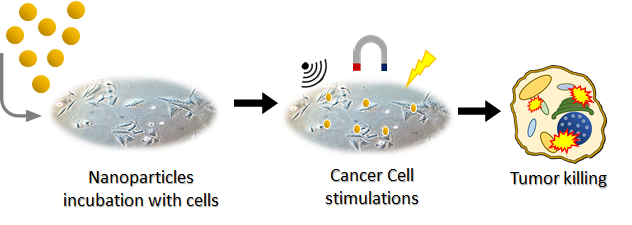
Despite carrying a drug, nanoparticles can act per se as a therapeutic agent, being capable of damaging and killing cancer cells throughout different mechanisms. This intrinsic mechanism can be often activated by an external stimulation, able to excite or trigger the nanoparticle from an hamless state to a highly harmful one.
Cancer is the second cause of death worldwide, with a dramatic perspective of continuous growth of new cancer cases and related deaths in the upcoming years.
Recent progresses in nanomedicine towards cancer treatment have exhibited that the use of nanoparticles can be truly promising. Despite carrying a drug, nanoparticles can act per se as a therapeutic agent, being capable of damaging and killing cancer cells throughout different mechanisms. This intrinsic mechanism can be often activated by an external stimulation, able to excite or trigger the nanoparticle from an hamless state to a highly harmful one. This is particularly desirable as soon as the nanoparticles are efficiently and selectively internalized by the target cancer cells. Several physical stimulations have been employed so far for this purpose, such as radiations, radiofrequencies, microwaves, light, and mechanical waves [1-2].
Our research team has devoted many effort in establishing a clear connection and synergy among the nanoparticles dose and the physical stimuli treatment, in order to produce a dramatic and specific cancer cell killing, while sparing healthy tissues [3-7]. The different key parameters for controlling the stimulation, the nanocrystals activation and their complex biological effects on cancer cells are under exploration. A full understanding of the mechanisms of action of this synergy is still under current debate or to be discovered.

Related Publications
